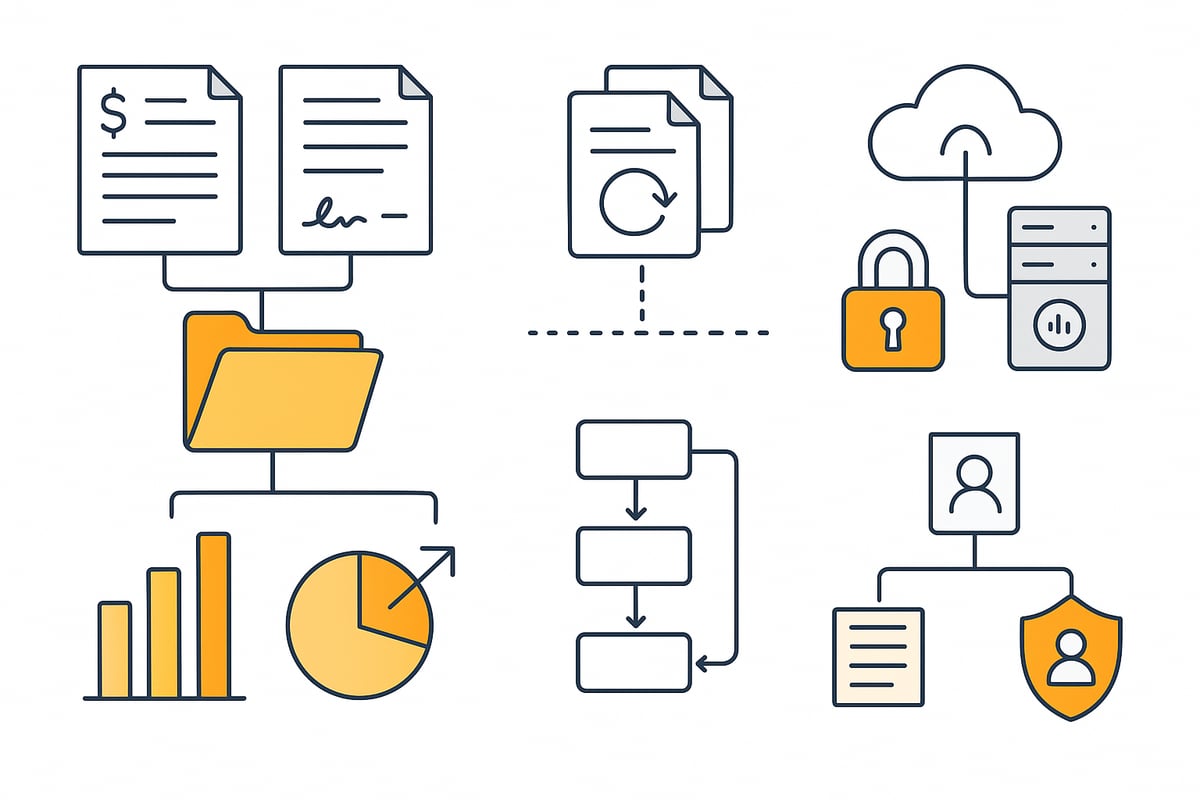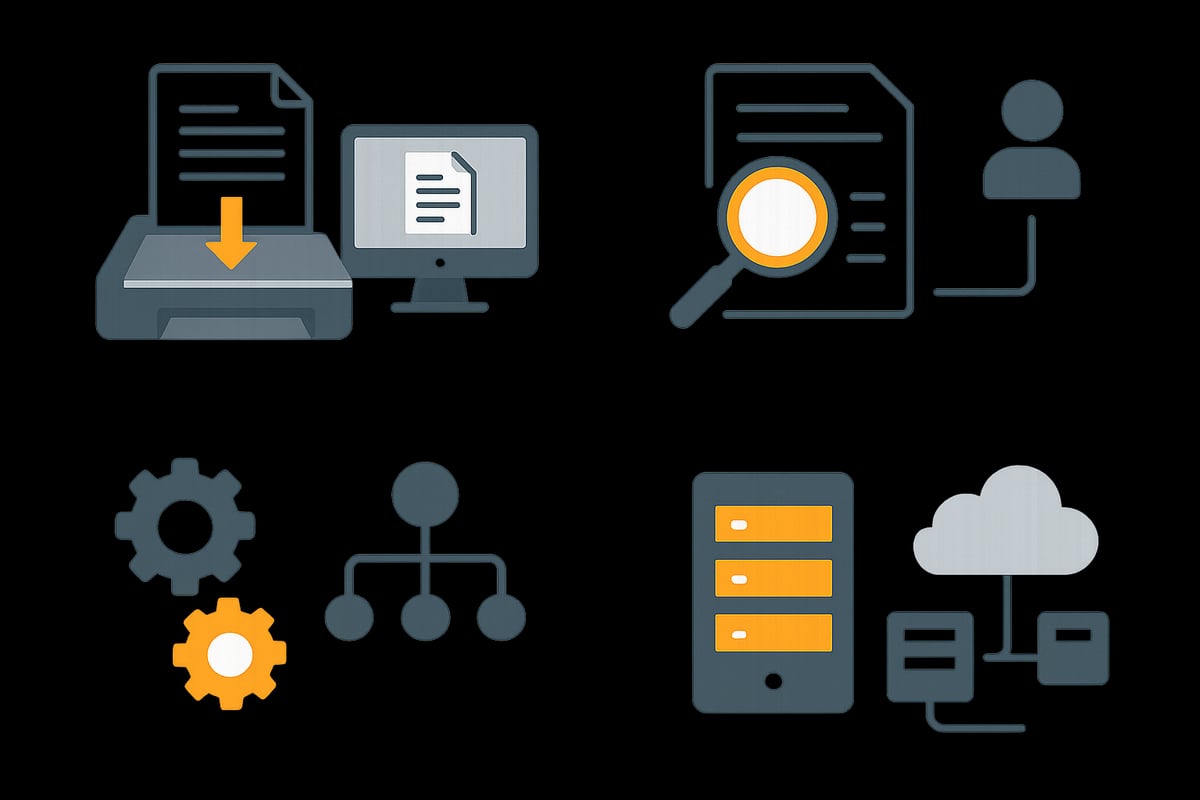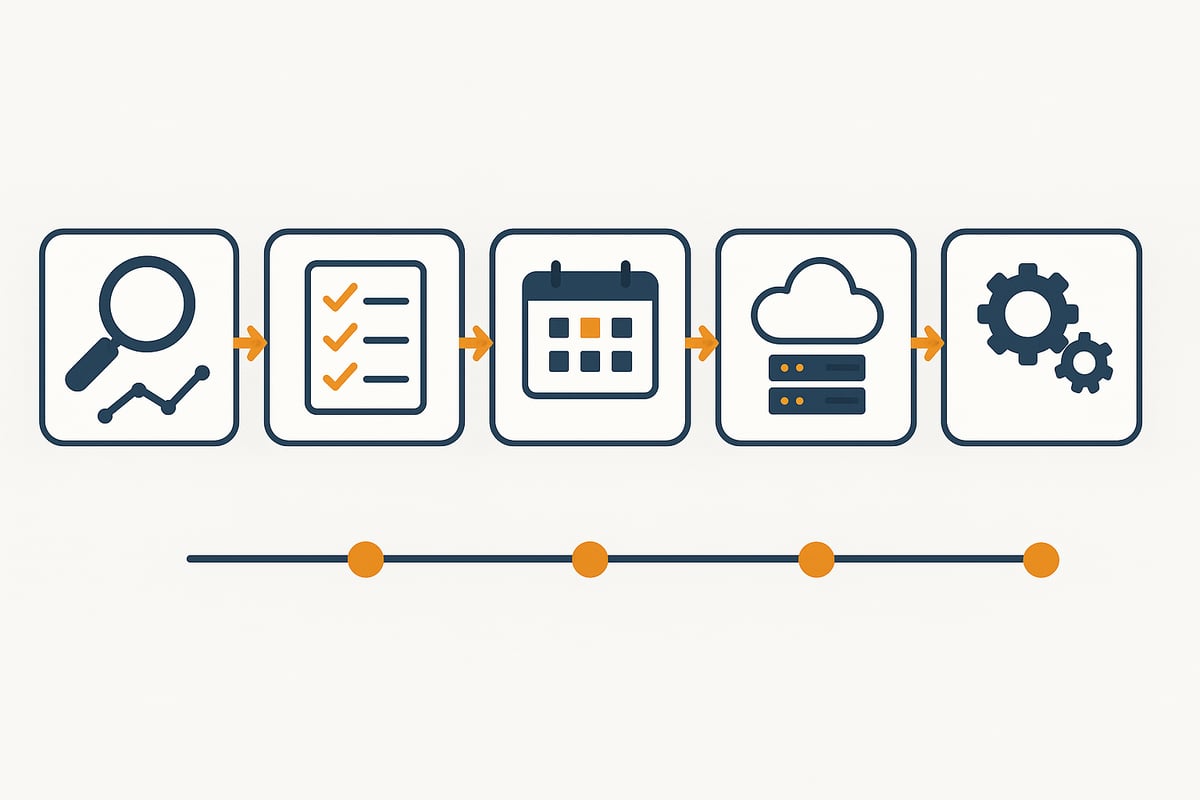Document Management System - Efficient Digital Management

Piles of paper on the desk, slow workflows and a lack of transparency – does that sound familiar? Especially in 2025, the question is whether these methods are still up to date for companies. Digital solutions are changing how we manage documents and control processes.
A modern document management system creates efficiency, security and gives your company a real competitive advantage. You benefit from faster workflows, better data protection and more transparency within the team.
In this guide, you’ll learn how to set up your document management to be future-proof, efficient and digital. You can expect the most important fundamentals, concrete benefits, key features, tips for selection and rollout, current trends and best practices.
What is a document management system (DMS)?
A digital flood of documents, growing demands on efficiency – a document management system is indispensable for companies today. But what’s actually behind the term? A document management system ensures that digital and scanned documents are managed in a structured, secure and central way. That means all information can be found at any time, is versioned in a traceable manner and is accessible to authorized users.

Definition and basics
A document management system (DMS) is a software solution that helps companies centrally store, organize and control their digital and paper-based documents. In contrast to pure archiving, which only covers long-term storage, a DMS also enables active editing, versioning and management of documents.
Typical components of a document management system include digital filing, change tracking, controlled access and the automation of workflows. The system is relevant for companies of any size and in any industry – from automated invoice processing to managing personnel files to contract administration. If you want to dive deeper into the basics, you’ll find a detailed Introduction to document management in our specialist article.
Types of DMS solutions
There are different types of document management systems: on-premise solutions are operated locally on the company’s servers, while cloud-based DMS (software as a service) are accessible via the internet. Monolithic systems often offer all features from a single source, while modular platforms are flexibly expandable.
A document management system can be chosen as an open-source variant or as a proprietary solution. The differences usually lie in maintenance, costs and scalability. Cloud DMS stand out through location-independent access and lower IT costs, which makes them particularly attractive for growing companies. The choice depends on which requirements dominate in the company.
Legal requirements and compliance
Every document management system should meet strict legal requirements. These include audit-proofing according to GoBD and IDW PS 880, which ensures that documents are archived immutably. Data protection and GDPR compliance are essential, especially when sensitive or personal data are processed.
Important compliance components include comprehensive logging of all access, fine-grained access control and automatic versioning. Many systems also offer automated deletion periods and audit trails to reliably meet legal requirements. This keeps the document management system on the safe side during inspections and audits.
The most important benefits of a digital document management system
A digital document management system fundamentally changes how companies work. Instead of paper chaos and wasted time, there are clear processes, fast access and greater security. The benefits range from increased efficiency to lower costs. Anyone who wants to remain competitive in 2025 can hardly avoid a modern DMS or ECM.

Efficiency and time savings
A document management system delivers immediate efficiency gains. Automated filing and central search functions make it possible to find documents in seconds instead of spending a long time searching for them. This reduces sources of error and saves valuable time in day-to-day business.
For example, automated workflows make it much faster to process recurring tasks such as invoice approvals or contract reviews. According to vendor information, time savings of up to 30 percent are possible. As Henry Ford once said: “Save yourself ten steps a day for ten thousand employees – that’s 50 miles less manual work.” If you want to learn more about automation, you’ll find details in the article on Automated workflows in the DMS.
Collaboration and transparency
With a DMS, teams always work with the current version of a document. All relevant documents are stored centrally, so everyone in the company has access – whether in the office, working from home or on the go.
Changes are logged transparently and can be traced at any time. This facilitates collaboration, speeds up approvals and improves response times to customer inquiries. Digital signature folders and shared records management are additional plus points that noticeably simplify everyday work.
Security and compliance
Sensitive data are especially protected in the document management system. Access rights are assigned on a role-based basis so that only authorized persons can access confidential information. Audit-proof archiving and comprehensive logging provide legal certainty.
Compliance with data protection and GDPR is ensured by automatic deletion and retention periods. With leading providers, these aspects are regularly audited according to IDW PS 880. Companies thus benefit from a high security standard and meet all compliance requirements.
Cost reduction and scalability
A DMS drastically reduces the costs for archiving, printing and storage. The central platform also lowers expenses for maintenance and operations. Companies can grow flexibly because the system can be easily adapted to new requirements.
Scalability is crucial, especially for growing businesses. The investment in a document management system therefore pays off twice: save today, stay flexible tomorrow.
Core features of a modern DMS
A modern DMS is far more than just a digital archive. It combines different features that help companies capture, manage and store documents in a legally compliant way. The following core areas show what matters when making your choice.

Document capture and filing
Digital capture is the heart of every DMS. Paper documents are automatically digitized via scanner and OCR. Digital files such as PDFs or Word documents also flow directly into the system.
Through digital mailrooms and email integrations, invoices, contracts or delivery notes end up in the document management system without detours. With categorization and tagging, users can quickly find documents later.
Typical examples:
-
Automated capture of incoming invoices
-
Integration of multifunction devices
-
Digital filing for personnel records
The goal: less paper, fewer errors, maximum oversight.
Search, versioning and access control
A powerful document management system enables fast search for any document. Full-text search, metadata search and filtering options ensure information can be found within seconds.
Versioning stores every change. This lets you restore older versions or trace who changed what and when.
Role-based permissions allow targeted access – for example to HR or accounting documents. Every action is recorded in the log, increasing transparency and security.
Workflow management and automation
With a DMS, business processes can be digitized easily. Workflows such as approvals, invoice checks or vacation requests are automatically controlled.
Systems offer interfaces to ERP, CRM and accounting software. Automatic notifications and deadline escalations ensure that nothing gets left behind.
Examples:
-
Digital signature processes
-
Automated contract approvals
-
Reduction of manual handovers
The result: fewer handoffs between systems, more efficiency.
Archiving, compliance and integrations
Audit-proof archiving is mandatory for every document management system. It meets GoBD and GDPR requirements, enforces automatic deletion periods and maintains audit trails.
Interfaces to systems such as SAP, DATEV or Microsoft 365 enable seamless integration into existing IT landscapes. Digital signatures and e-invoices can also be integrated.
If you want to learn more about the benefits of digital archiving, you’ll find practical tips and best practices here.
This keeps your company on the safe side while also benefiting from maximum flexibility.
Step by step: Implementing a document management system
Implementing a DMS is a multi-stage process that requires structured planning and collaboration. With a clear roadmap, the move from paper to digital succeeds efficiently and safely. Below you’ll find the most important steps to successfully introduce your document management system.

1. Needs analysis and goal definition
Start with analysis: where do media breaks, time losses or compliance risks occur? Review how current processes run and which document types are particularly time-consuming. Typical problem areas include invoice processing, personnel records or contract management.
Involve all relevant departments early on. Define the goals for the DMS together, for example more efficient workflows, better compliance or cost reduction. Document these goals clearly so everyone knows what matters.
2. Selecting the right DMS solution
Now it’s about finding the right document management system solution. Consider whether a cloud or on-premise solution better fits your requirements. Check integrability, scalability and industry-specific features.
Create a checklist with must-have and nice-to-have criteria, compare vendors and pay attention to data protection, support and updatability. Flexibility for hybrid work models is especially important, as described in the article ERP trends 2025: Hybrid working models and DMS. These trends help you make a future-proof decision.
3. Planning and preparation for rollout
With the selection of the document management system, concrete planning begins. Set up a project plan with clear timelines and responsibilities. Appoint a digitalization officer who acts as an interface between IT, business units and external partners.
Make sure all employees are informed and their questions are addressed. Plan training and communication measures to promote acceptance and motivation. Thoughtful preparation is the key to a smooth start.
4. Implementation and migration
In this phase, the document management system is introduced technically. Digitize paper documents and migrate existing data into the new system. Adapt workflows to digital processes and conduct pilot projects, for example for the digital mailroom.
Train users in a hands-on way and ensure a gradual transition. Test all features thoroughly before the DMS goes live. This allows sources of error to be identified and resolved early.
5. Operation, control and continuous optimization
After introducing the document management system, it’s time to monitor and continuously improve processes. Use analysis and reporting tools to check usage and acceptance. Collect feedback regularly, adjust workflows and integrate new features as needed.
Pay attention to compliance and security. Only then will the document management system remain efficient and future-proof in the long term. Continuous optimization ensures your company can respond flexibly to changes.
AI and innovation: Trends in document management 2025
The world of document management systems is at a turning point in 2025. Innovative technologies such as AI and automation are changing how companies store, edit and use documents. What are the most important trends you should know?
Artificial intelligence in the DMS
Artificial intelligence is long past being just a buzzword in the DMS space. AI algorithms analyze and classify documents automatically. This saves time and reduces errors.
Typical applications include automatic extraction of invoice data and intelligent assignment to projects or departments. Interactive chat-based AI is being used more and more, allowing you to query documents as if in a conversation.
AI-based workflows facilitate approvals and contract management. According to current vendor trends, the share of AI-supported features in the document management system is steadily increasing.
Automation and integration
Automation is the key to efficient processes in the document management system. No-code or low-code workflows enable users to design processes without programming knowledge.
Seamless integrations with ERP, CRM or email systems ensure that information ends up where it’s needed. Automated processing of e-invoices and digital signatures is particularly in demand.
Open interfaces and API usage are gaining importance. For a comprehensive overview of current trends and the role of AI, see the article Trends 2025: Digital transformation in document management.
Future-proof DMS strategies
If you want to make your document management system ready for the future, rely on cloud-first approaches or hybrid models. These offer flexibility and enable mobile work.
User-friendliness is in focus, because user acceptance determines success. At the same time, the requirements for data protection and data sovereignty are increasing, especially when dealing with sensitive data.
Sustainability is becoming more important: digital processes in the DMS save paper and conserve resources. Forecasts show that DMS are increasingly becoming a central building block of corporate digitalization.
Efficient document automation with filehub
filehub is a German platform that revolutionizes the document management system with automated workflows. The solution connects different software and web portals without programming and automates multi-step processes.
As a GDPR-compliant and C5-certified platform from Germany, filehub integrates seamlessly with email software, cloud storage, financial accounting programs and many document management systems. This allows companies to easily digitize routine tasks such as processing invoices and make their processes more efficient. A free start and scalable plans make filehub interesting for companies of any size.
Best practices for successfully using a DMS
A document management system only unfolds its full potential if the right best practices are lived in everyday work. From team acceptance to continuous optimization: these five success factors help you get the most out of your digital solution.
Employee acceptance and change management
Introducing a DMS only succeeds if the team is involved early. Openness to new processes arises through transparent communication and by showing the advantages in everyday work.
Important measures:
-
Actively involve employees in planning
-
Communicate the goals and benefits of the project clearly
-
Provide training and support, for example through a “digitalization officer”
The growing importance of digital document management systems is also reflected in current forecasts: According to the market forecast for document management systems through 2032, the market will continue to grow strongly.
Customization and scalability
Every company works differently – that’s why the document management system should be flexibly configurable. Only then can workflows be optimally adapted to existing processes.
Practical tips:
-
Review workflows regularly and optimize them if necessary
-
Choose expandable systems that grow with the company
-
Use open-source or update-capable solutions for long-term flexibility
This keeps your system stable and high-performing even as things change.
Ensure compliance and security on an ongoing basis
A document management system must remain secure and legally compliant at all times. This primarily concerns data protection, but also compliance with legal requirements such as GoBD or GDPR.
Best practices:
-
Continuously review access controls and logs
-
Set up automated deletion and archiving processes
-
Regular external audits for quality assurance
This protects sensitive data and minimizes legal risks.
Integration and automation as the key to success
The true strength of a DMS lies in seamless integration with existing tools and the automation of recurring tasks. This saves time and reduces sources of error.
Recommended steps:
-
Use interfaces to ERP, CRM or email systems
-
Set up automated workflows for mailroom, invoice verification or contract management
The better the systems work together, the more efficiently your processes run.
Monitoring and continuous improvement
A document management system is not a one-off solution. Only through regular monitoring and continuous optimization will you get the full benefit from your system.
Rely on:
-
Analysis and reporting tools for process monitoring
-
User feedback as a basis for improvements
-
Continuous improvement process (CIP) in operations
This keeps your document management system up to date at all times and lets it grow with your requirements.
So you finally want to spend less time on paperwork and manual processes and instead work efficiently in digital? With the latest tips and best practices from our guide, you know what matters in document management in 2025 – from legal certainty to smart automation. Now it’s up to you to take the next step: try filehub and experience for yourself how easily you can automate document workflows without writing a single line of code. Get started right away and discover how much potential lies in your company – try filehub.one for free now


